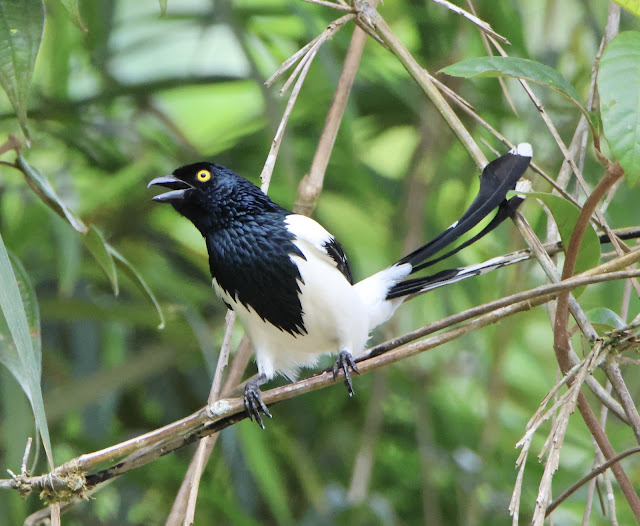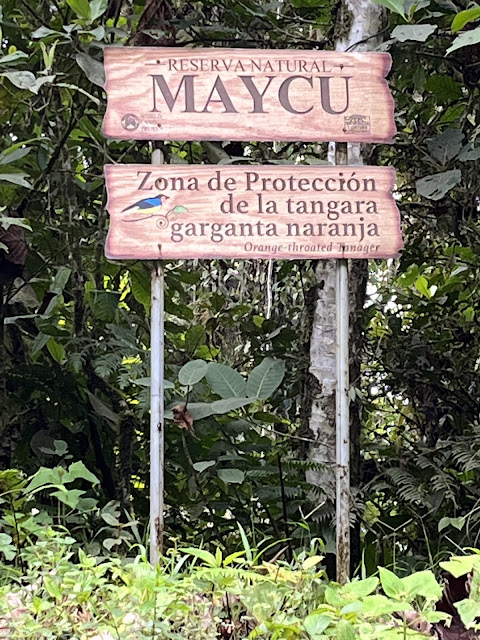From looking at the map I assumed Irving would take us NE along the Zamora River to where the Nangaritza River, the one that goes by Yankuam, empties into it, but we turned south across the Zamora way before then, and were driving into hilly terrain. A half hour after that we could see a town off to the east, which Irving said was Paquisha, which I knew was along the Nangaritza River, so I knew for sure he had taken a short cut. Not long into this part of the jaunt the road turned to gravel, and remained such for the rest of the way, which was at least a 90 minute drive. It was mostly farm land near the road, but little by little the mountains on each side of us got closer so that eventually there was very little farmland and more and more pristine jungle on the slopes.
But before we turned away from the muddy Zamora, we went through a small town where they were having an Ecuadorian version of a Hawaiian luau. There were a few small storefronts where a large hog was hanging up by his front feet and large chunks of meat had gone onto the barbecue. Lots of people there just “pigging” out. I would have loved to have gotten a picture, but just did not have the opportunity.
WHEREVER THERE WAS LOTS OF RIVER ROCK VISIBLE WAS EVIDENCE OF MINING
I asked Irving if the mining reached the Yankuam area, and he said it did not. (But it resumes farther upriver) By the time we reached Yankuam the road certainly had its bad spots, and just before we got there it looked almost like a dry riverbed for a hundred meters or so.
We were heartily greeted by the owners Carlos and Clarita. We had our pick of the cabins/rooms as no one else would be here during our 4 day stay. I asked Carlos about a room that would not be so hot, so he said to stay on the lower level. As it was about 1:30 he asked us if we’d like lunch, to which we agreed, so after unpacking and getting somewhat settled, we went over for bean soup, fish, rice and corn patties. A little later he brought over what looked like 2-3 foot bean pods which he called “Guava de Monos,” or, Guava for the Monkeys. He demonstrated how to break them open and eat them, and the pulp that surrounded the large seeds tasted sweet, so we each ate one. I went out front afterward to find Clarita and Irving eating them, so I asked if there were monkeys in the area. Irving pointed to someone in the tree where the pods were, eating one of them. We all had a good laugh about that.
GUAVA DE MONOS
After lunch Rosie took a rest while I went for a walk of about an hour and a half. First I walked south to where there is a bridge across the river, and then north for about a half mile past the cabins. I was able to take a pic of a Magpie Tanager right out of the gate, which I was fairly pleased about. Later on I got pics of a Violaceous Jay and Silver-beaked Tanager.
THE BRIDGE JUST UPRIVER FROM YANKUAM. I SHOULD HAVE ASKED CARLOS ABOUT THE ORIGIN OF THE LARGE TOUCAN AND WARRIOR FIGURE WITH IT.
VIOLACEOUS JAY
MAGPIE TANAGER
A TREE WITH OROPENDULA NESTS. ACTUALLY A COMMON SITE
I also added 2 lifers: a Yellow-backed Tanager and a Chestnut-eared Aracari. The tanager was in a mixed flock of some 20 birds which included Black-masked Dacnis, Blue Honeycreepers, Blue-necked Tanagers and a Green-and-Yellow Tanager. (This made for a dazzling array of blues, greens and yellows). I also started hearing, then seeing Blue-headed Parrots flying in the distance, and soon began to realize they were all over the place. It was starting to sink in that this area was living up to its reputation as a great birding location. Except for the gold mining along the river, this was an amazing place, almost untouched by human hands.
We decided not to eat that evening as we had a late lunch. We noticed early in the afternoon that the WiFi was not working, so when I could see that Carlos and Clarita were done eating, I went over to the dining area to ask them about it. It was then that I came to understand that the electricity was out. I ended up talking with them for a while, and then Rosie came out and joined us, and we talked for almost another hour, using the Google translate app. We showed them pictures of our home in Oregon, our garden and our cats. (Yep, pics of Buster make everyone laugh).
HE ALWAYS SLEEPS ON HIS BACK, VERY UNCAT-LIKE
Clarita then gave us a candle so we’d have some light to get ready for bed. After hitting the sack we stayed awake listening to all the jungle noises, mostly frogs and insects. It was serene.
I set the alarm for 5:00 so we’d be up for breakfast early and be ready when Christian arrived, but Rosie woke me saying it was 5:03, and I must have set the alarm for PM instead of AM. Good thing she woke up or it would have been a late start. We had granola, eggs and some kind of corn muffin/roll type of thing, juice and coffee. Christian had left his house at 03:00 to get here by 05:00. To my eye the weather looked a little foreboding, and there were a few sprinkles coming down, but Christian did not seem concerned. So we headed out, up the hill to Maycu Reserve, set aside for the Orange-throated Tanager.
We hired Christian to guide us birding for 3 full days there. The first morning we birded the Maycu Reserve, and in the afternoon around the lodge area. The second morning it was back to Maycu for a couple hours and then on past there to the road to Shiame, a small village upriver from Yankuam. It might be of interest to explain that a small part of the road past Maycu actually goes into Peru for a few hundred meters, and a family from the Shuar indigenous tribe live there and sell bananas. I had Christian stop there so we could put our feet on Peruvian soil and make a short list of the birds seen there, which consisted of 8 species in 5 minutes. Here we are in Peru…..
In the afternoon we took that boat ride up the Nangaritza River (see that blog). About 8:00 PM Christian and I went for a walk trying to coax some owls to respond to playback. After about an hour we were ready to give up when a Band-bellied Owl piped up, flew in and landed on a tree nearby. He shined the spotlight on him, and I got great looks at another lifer.
The 3rd day found us heading north along the road we came in on, back toward civilization, specifically looking for rail-type birds, of which 4 were possible. We got responses from both Blackish an Chestnut-headed Rails, but none would come out into the open. In the afternoon Christian and I went back to Maycu, me thinking it would be the last time there. It was somewhat of a finale for me in that the birds appeared thick and some good ones posed for pics. I should mention that walking along the road that goes through Maycu is simply fantastic for birding. Sometimes it took an hour to walk 100-200 meters because birds kept coming and going.
Carlos and Clarita were great hosts, ever attentive to our needs. They were happy to serve our meals whenever it suited our schedule. The place is a little rustic by US standards, but that was OK with us. Whatever short-comings the place may have had, it was compensated well with great hosts and great birding. They had a young dog named Shambo, who was often getting into mischief, so we started calling him Rambo. He slept outside our cabin door, and whenever we walked out from the lodge, he was right there with us. We also tried to brake him of his habit of chasing motorcycles. At mealtime he was right under the table hoping for scraps.
SHAMBO, OR, RAMBO
WHITE-BANDED SWALLOWS, A SPIFFY BLACK SWALLOW WITH A LARGE WHITE BAND ACROSS ITS CHEST
ONE OF THE MANY BUTTERFLIES. I SOMETIMES WISH I TOOK PICS OF THEM FOR A SEPARATE BLOG
HERE WE ARE WITH CHRISTIAN BEFORE HE LEFT BACK TO YANTZAZA
During the periods of down time when not birding, I’d go up onto the front porch on the 2nd floor above us to watch for birds and write narratives while they were fresh in my mind. Occasionally I’d get a decent pic up there. Rambo always followed me up like a faithful friend. There was a tree right next to the cabin that was loaded with small fruits which were just getting ripe, attracting birds. Here are some pics from up there:
GREEN-AND-GOLD TANAGER EATING ONE OF THE BERRIES
SUMMER TANAGER
SHORT-CRESTED FLYCATCHER
GLITTERING THROATED HUMMINGBIRD
BLUE-NECKED TANAGER. I SIDE VIEW OF THIS BEAUTY WOULD HAVE BEEN IMPRESSIVE
LEMON-BROWED FLYCATCHER
FORK-TAILED WOODNYMPH - FEMALE
On the late afternoon of our 3rd day, after seeing Christian off, Carlos offered to take me back up to the Maycu Reserve before breakfast in the morning. I actually wanted to sleep in, but figured I had better oblige him for the offer. So at 06:00 we were off again to Maycu, my 4th time to walk there. It would only be for 2 hours. Carlos is 71, but does not look it. His eyes and ears are still in great shape. While slowly walking along the road, he heard a Musician Wren, and signaled the vocalization out to me. An unseen lifer! Soon his ears picked out the dawn song of the Orange-throated Tanager. There was a small group of them to the downhill side of us, and they were slowly working their way toward us. In a couple minutes they were nearer, and lower than usual, not up in the treetops. I took over 100 pictures of a few of them, and finally obtained some decent ones. Here’s the best one:
ORANGE-THROATED TANAGER
I think we had granola, fruit, juice/tea, eggs, yogurt, and coffee every morning while there. They were always heaping portions, so we never ate everything. After our last breakfast Rosie and I went for a walk. We went south to the bridge and then back past Yankuam for maybe a half mile. On our way back the taxi driver Irving came by, so we knew we had to finish packing right away.
Just before leaving we took some photos of Carlos and Clarita, and then of the four of us. They are some of the nicest folks. As they are getting along in age, I wonder what will become of their lodge since their son has passed away and their daughter lives in Sweden. I felt I should not be nosy and ask, but I’d sure like to see the place live on for many more years.
HERE’S A SHOT OF THE LARGE MAP IN BACK OF US, ON THE WALL. THE YELLOW LINE IS THE BORDER BETWEEN ECUADOR AND PERU. IF YOU ENLARGE IT YOU CAN SEE WHERE THE ROAD TOUCHED THAT YELLOW LINE.



























No comments:
Post a Comment